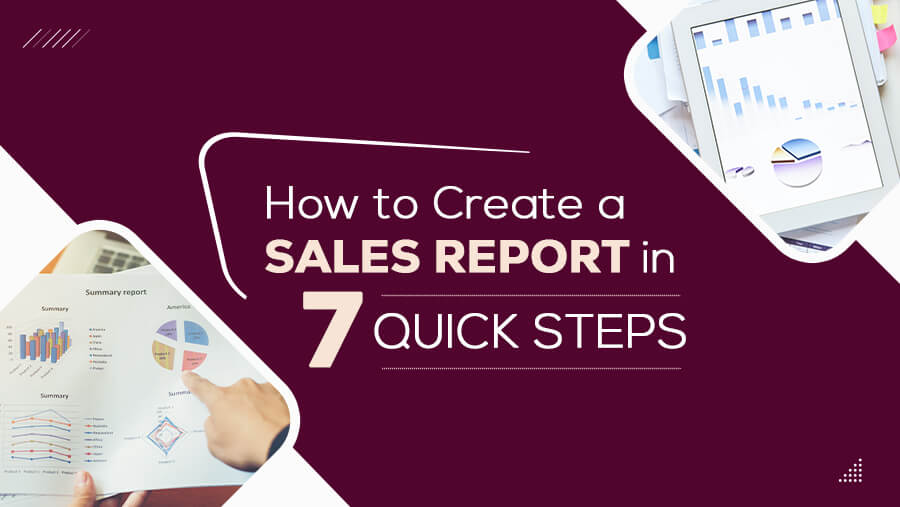
7 Steps to Create Impactful Sales Reports
It’s common for us, sales professionals, to collect sales data from our various initiatives. However, do you think you have utilized these numbers to their full potential?
If you answer no, you should focus on a well-crafted sales report. It can provide invaluable insights into your business performance, helping you:
- Identify trends
- Make data-driven decisions
- Drive growth
This document will help you predict future sales trends, reveal your top-performing products, and pinpoint areas for improving customer satisfaction.
This guide will walk you through the step-by-step process of creating an informative and actionable sales report.

Step 1: Determine the Goal of Your Sales Report
Be sure of your report's end goal before digging into the data.
- What precise facts do you want to get across?
- Do sales trends, best-selling items, or client happiness catch your attention?
- What objectives do you hope to fulfill with this report?
- Are you looking to boost sales, enhance client retention, or streamline your sales process?
Once your ultimate objectives are clear, the correct data may be chosen, prioritized, and analyzed. As a result, you'll ensure your sales report provides recommendations to improve the bottom line.
Step 2: Determine Your Target Audience
Next, think about your audience. After all, they are the ones who will be reading and using your report. So, ask yourself these questions:
- Who will be the report’s primary readers?
- What will be the role of your sales team?
- Will the executive leadership be involved?
- What about your stakeholders?
- Will there be a mix of the above groups?
Knowing your audience will enable you to better tailor your report's format and content to their requirements and interests. This entails concentrating on the data that matters most to them and delivering it understandably and practically.
Step 3: Gather Relevant Data
Now that you have a clear purpose and understand your audience, it's time to gather the relevant data for your sales report. This data will be the foundation of your analysis and insights.
Here are some key sources to consider:
- Customer Relationship Management Platforms: Your CRM system is a repertoire of sales data, including customer information, sales history, and pipeline data.
- Salesforce Reports: Salesforce provides standard and custom reports for analyzing your sales performance.
- Sales Data Spreadsheets: If you're not using a CRM, you may have sales data stored in Excel files.
- Third-party Data Sources: Depending on your specific needs, you may also need to consider third-party data sources, such as market research reports or industry data.
PRO TIP: Don’t simply collect all data types. Gather only those metrics that align with your report's objective and are relevant to your audience.
Step 4: Analyze and Interpret the Data
Once you've gathered your data, it's time to analyze and interpret it. This involves:
- Cleaning and Preparing Your Data: Ensure the data is accurate, consistent, and error-free.
- Identifying Trends: Look for meaningful patterns in the data to help you understand your sales performance.
- Calculating Key Metrics: Calculate relevant KPIs, such as:
- Sales revenue
- Average deal size
- Conversion rates
- Customer lifetime value
You can use this chart for the formulas to derive the above numbers:

- Comparing Data to Benchmarks: Compare your sales data to industry benchmarks or historical performance to identify areas for improvement.
Also, remember to use appropriate data analysis techniques, such as:

Step 5: Create a Clear and Concise Narrative
Once you've analyzed the data, you need to create a narrative telling your sales performance story. This involves:
- Organizing the Data: Structure the data in a logical and easy-to-follow manner.
- Highlighting Key Findings: Emphasize the most important trends, insights, and recommendations.
- Using Crisp and Simple Language: Avoid technical jargon and write in a way that is easy for your audience to understand.
- Supporting Claims with Data: Use data to back up your claims and make your report more credible.
Remember, your goal is to create an informative and engaging report. A well-written narrative will help you communicate your findings effectively and drive action.
Step 6: Visualize Your Data
Data visualization is a powerful tool for making your report more engaging and easier to understand. By using charts and graphs, you can:
- Simplify Complex Data: Break down complex data into more digestible formats.
- Highlight Key Trends: Visually emphasize essential trends and patterns.
- Make the Report Visually Appealing: Enhance the overall presentation of your report.
Some common chart types to consider include:

Choose the chart types that best suit your data and audience's needs.
Step 7: Share Your Insights and Drive Action
Once you've finalized your report, it's time to share your insights with the appropriate stakeholders. This could include:
- Your Sales Team: Provide them with the information they need to improve their performance.
- Executive Leadership: Share critical findings and recommendations that can inform strategic decision-making.
- Investors: Update them on the company's sales performance and progress towards goals.
Remember, the goal of your sales report is to drive action. Use your insights to:
- Identify Gap Areas: Pinpoint opportunities to increase and optimize your sales process.
- Celebrate Successes: Recognize and reward your sales team for their achievements.
- Make Data-driven Decisions: Use the insights from your report to inform your business strategy.
Sales Report Templates
Now that you have a step-by-step guide to making a sales report, here are some samples to help you start your workflow:
Template 1: Steps to Creating a Sales Report

Template 2: Sample Sales Report Outline

Final Word
By following the steps outlined in this guide, you can create a comprehensive and informative report that provides valuable insights and drives action.
Remember, a well-crafted sales report reflects your company's commitment to data-driven decision-making. Investing time and effort into creating high-quality reports can improve your sales performance, optimize your sales process, and achieve your business goals.




